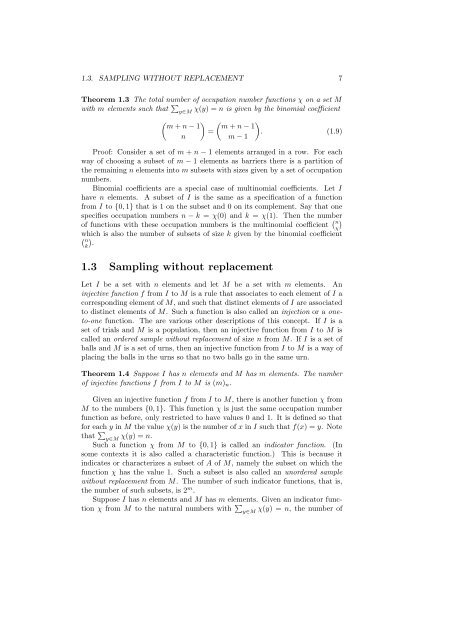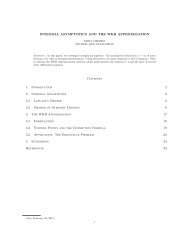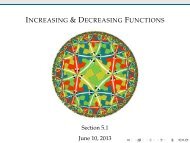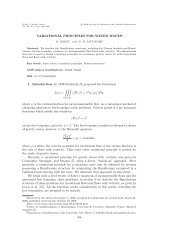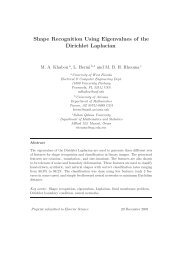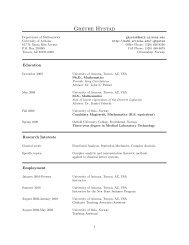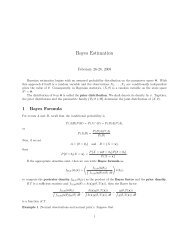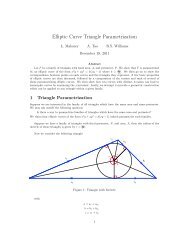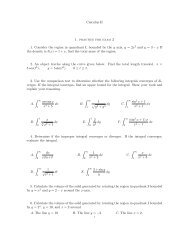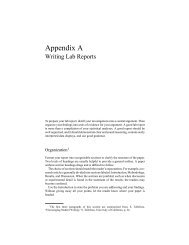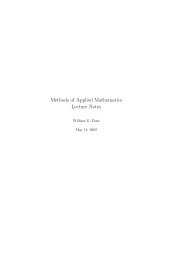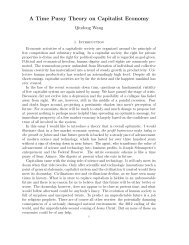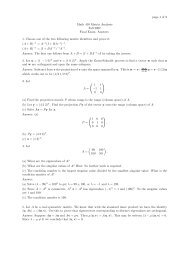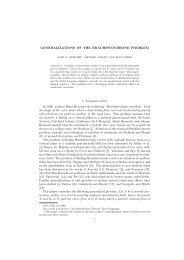Lectures on Elementary Probability
Lectures on Elementary Probability
Lectures on Elementary Probability
Create successful ePaper yourself
Turn your PDF publications into a flip-book with our unique Google optimized e-Paper software.
1.3. SAMPLING WITHOUT REPLACEMENT 7<br />
Theorem 1.3 The total number of occupati<strong>on</strong> number functi<strong>on</strong>s χ <strong>on</strong> a set M<br />
with m elements such that ∑ y∈M<br />
χ(y) = n is given by the binomial coefficient<br />
( ) ( )<br />
m + n − 1 m + n − 1<br />
=<br />
. (1.9)<br />
n<br />
m − 1<br />
Proof: C<strong>on</strong>sider a set of m + n − 1 elements arranged in a row. For each<br />
way of choosing a subset of m − 1 elements as barriers there is a partiti<strong>on</strong> of<br />
the remaining n elements into m subsets with sizes given by a set of occupati<strong>on</strong><br />
numbers.<br />
Binomial coefficients are a special case of multinomial coefficients. Let I<br />
have n elements. A subset of I is the same as a specificati<strong>on</strong> of a functi<strong>on</strong><br />
from I to {0, 1} that is 1 <strong>on</strong> the subset and 0 <strong>on</strong> its complement. Say that <strong>on</strong>e<br />
specifies occupati<strong>on</strong> numbers n − k = χ(0) and k = χ(1). Then the number<br />
of functi<strong>on</strong>s with these occupati<strong>on</strong> numbers is the multinomial coefficient ( )<br />
n<br />
χ<br />
which ) is also the number of subsets of size k given by the binomial coefficient<br />
.<br />
( n<br />
k<br />
1.3 Sampling without replacement<br />
Let I be a set with n elements and let M be a set with m elements. An<br />
injective functi<strong>on</strong> f from I to M is a rule that associates to each element of I a<br />
corresp<strong>on</strong>ding element of M, and such that distinct elements of I are associated<br />
to distinct elements of M. Such a functi<strong>on</strong> is also called an injecti<strong>on</strong> or a <strong>on</strong>eto-<strong>on</strong>e<br />
functi<strong>on</strong>. The are various other descripti<strong>on</strong>s of this c<strong>on</strong>cept. If I is a<br />
set of trials and M is a populati<strong>on</strong>, then an injective functi<strong>on</strong> from I to M is<br />
called an ordered sample without replacement of size n from M. If I is a set of<br />
balls and M is a set of urns, then an injective functi<strong>on</strong> from I to M is a way of<br />
placing the balls in the urns so that no two balls go in the same urn.<br />
Theorem 1.4 Suppose I has n elements and M has m elements. The number<br />
of injective functi<strong>on</strong>s f from I to M is (m) n .<br />
Given an injective functi<strong>on</strong> f from I to M, there is another functi<strong>on</strong> χ from<br />
M to the numbers {0, 1}. This functi<strong>on</strong> χ is just the same occupati<strong>on</strong> number<br />
functi<strong>on</strong> as before, <strong>on</strong>ly restricted to have values 0 and 1. It is defined so that<br />
for each y in M the value χ(y) is the number of x in I such that f(x) = y. Note<br />
that ∑ y∈M<br />
χ(y) = n.<br />
Such a functi<strong>on</strong> χ from M to {0, 1} is called an indicator functi<strong>on</strong>. (In<br />
some c<strong>on</strong>texts it is also called a characteristic functi<strong>on</strong>.) This is because it<br />
indicates or characterizes a subset of A of M, namely the subset <strong>on</strong> which the<br />
functi<strong>on</strong> χ has the value 1. Such a subset is also called an unordered sample<br />
without replacement from M. The number of such indicator functi<strong>on</strong>s, that is,<br />
the number of such subsets, is 2 m .<br />
Suppose I has n elements and M has m elements. Given an indicator functi<strong>on</strong><br />
χ from M to the natural numbers with ∑ y∈M<br />
χ(y) = n, the number of


